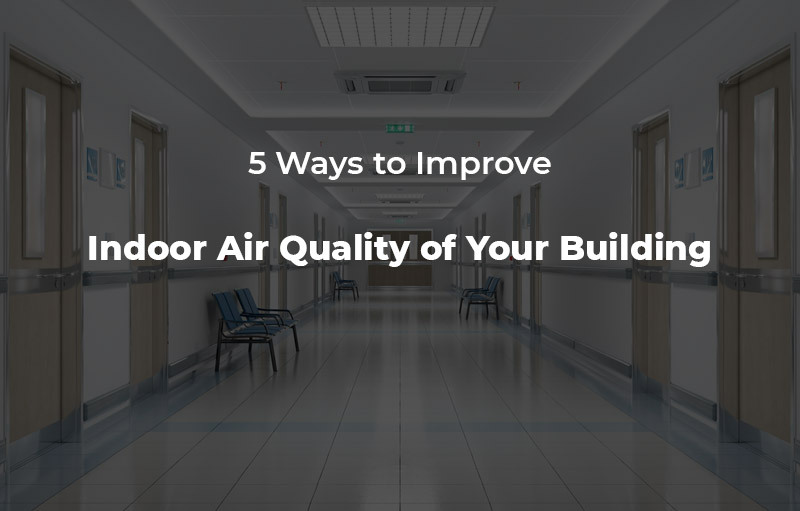
21 Oct 5 Ways to Improve Indoor Air Quality of Your Commercial Building
Ever since COVID-19, we have all learned the importance of good Indoor Air Quality. In this blog, we talk about 5 Ways to Improve Indoor air quality of Your Building.
Why is Indoor Air Quality Important?
Most of us spend up to 90% of our time indoors, either working in our offices or at our homes. Studies conducted by the Environmental Protection Agency (EPA) and others show that indoor environments sometimes can have levels of pollutants that are higher than levels found outside. Pollutants in our indoor environment can increase the risk of illness. Poor indoor air quality can also affect the productivity, health and eventually put you at risk of non-compliance with NYC Local Law such as the NYC Local Law 55.
Even clean, well-run buildings can expose occupants to indoor air pollution from time to time.
Following are 5 tips to improve and maintain Indoor Air Quality in Your Buildings.
1- Check your heating, ventilation, and air conditioning (HVAC) system
Your building’s HVAC system plays a crucial role in maintaining your indoor air quality. Airflow from the HVAC can help move indoor pollutants through the building, keeping them from building up in any one area. Exhaust fans connected to your air ducts also help with IAQ by creating a path for polluted air to exit your building. Make sure to perform regular maintenance on your HVAC system to keep it in good working order. The American Society of Heating, Refrigerating and Air-Conditioning Engineers (ASHRAE) recommends annual ductwork inspections; semiannual cleaning, lubrication, and adjustment; and quarterly filter cleaning or replacement. Any time you perform routine maintenance, check that the HVAC vents aren’t blocked by any office furniture, décor, signage, or equipment.
2- Conduct Regular Air Tests
Performing an indoor air testing will provide you with the right information and insights to make your IAQ improvement plan more directed and efficient. Air quality tests include checking humidity levels, airflow, ventilation, mold growth, odors, and water damage.
3- Manage Humidity Levels
Many biological pollutants, including mold and pests, thrive in warm, humid environments. When the relative humidity in a building is too high, it can lead to the growth and spread of these pollution-causing organisms, damage building materials and furniture, and impact the health and comfort of workers. On the other hand, dry air isn’t great for people or buildings either. If the relative humidity in your office building is too low, workers may be more likely to develop dehydration and respiratory issues, including asthma attacks, nosebleeds, bronchitis, and sinusitis.
It is recommended to have indoor air quality monitors that can help maintain the optimal relative humidity in the building. When the building is too humid, you can dry the air by opening windows, running the air conditioner, or using a dehumidifier. If the air gets too dry, you can raise the relative humidity by using a humidifier or vaporizer.
4- Observe Proper Ventilation
Whenever possible, turn of your HVAC system and open the windows to allow outdoor air to enter the building. Be sure to keep air vents unblocked. Placing furniture, storage boxes, chairs, or cabinets in front air vents will disrupt air circulation, causing your workplace to feel stuffy. Indoor plants are also a great addition to your office. They are not only refreshing to the eyes but can also help promote your indoor air quality by absorbing carbon dioxide and releasing oxygen into the air.
5- Control Indoor Air Pollution at the Source
When it comes to preventing indoor air pollution, the first step is pinpointing the main offenders in your office building. These can include pesticides, cleaning chemicals, solvents, adhesives, and paints. If possible, only use high-VOC products after most employees are gone for the day. Then, open windows and increase ventilation to help the building air out before people return to work.
During any renovations, work with the construction crew to ensure that you’re using low-VOC paints, adhesives, flooring, and wood products. Any new furniture should be allowed to air out in an unoccupied room before it’s brought into the office. To keep outdoor pollution from entering the building, keep doors and windows closed when outdoor air quality is poor.
Indoor air quality should be one of the most important concerns in your workplace as it directly affects the overall health and well-being of your staff and employees. Poor IAQ can increase the risk of many health problems, from respiratory illnesses to infections. It can even compromise your mental health. The Cotocon Group has expertise in consulting building owners on how to improve their Indoor air Quality. Contact us to know more!
